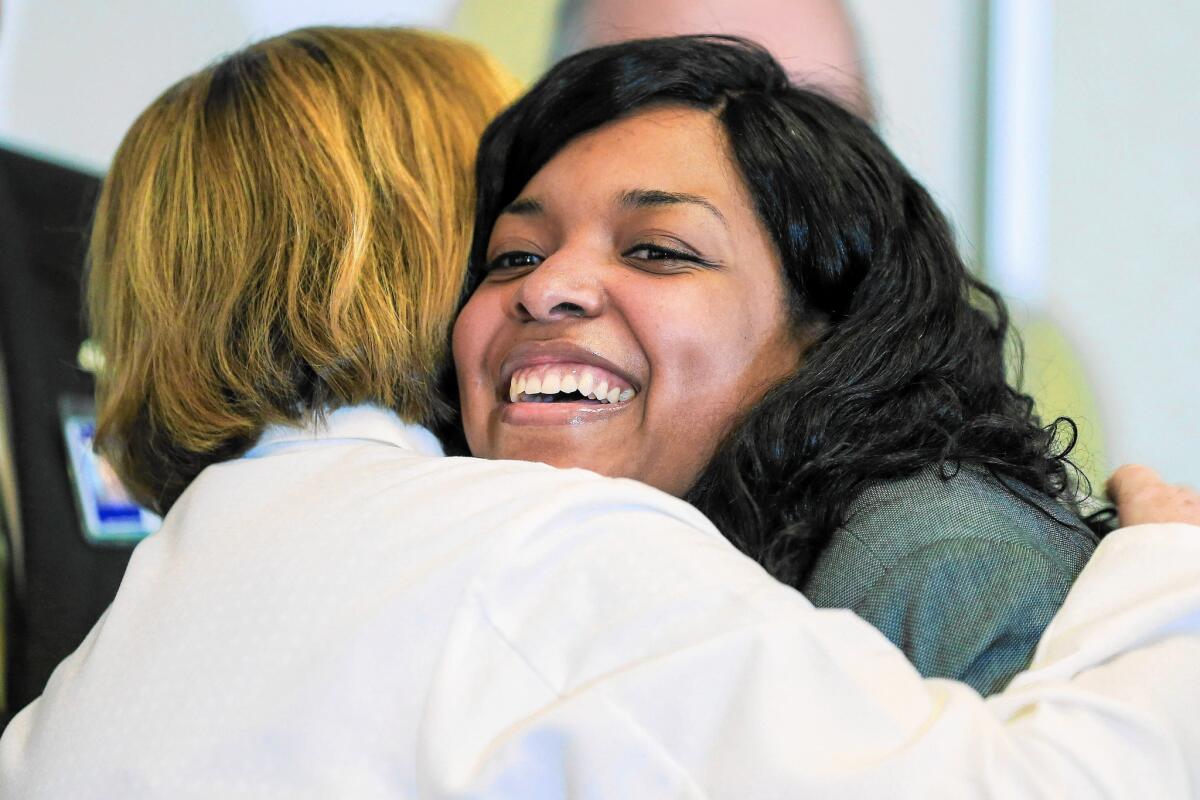U.S. cases prove Ebola is ‘not a death sentence’

- Share via
When Amber Vinson walked out of Emory University Hospital in Atlanta on Tuesday, she became the sixth person in the country to be successfully treated for a disease that kills 70% of its victims in Africa, but has so far killed only one in the United States.
Long thought to be a death sentence, Ebola has proved vulnerable to a mix of standard and invasive medical techniques, readily available in the U.S. but often beyond the reach of the impoverished nations at the heart of the outbreak.
Breathing tubes, large-bore intravenous lines, blood dialysis, electrolyte monitoring and around-the-clock attention are largely responsible for the survival of patients under advanced Western care, experts say.
Though few in number, these highly publicized patient successes have sparked a rethinking of the lethality of the disease and the power of relatively basic medical procedures to change its course.
“It’s not a death sentence,” said Michael Buchmeier, a virologist at UC Irvine. “It’s a beatable disease.”
Vinson, along with a second nurse, Nina Pham, became infected while treating Liberian patient Thomas Eric Duncan at Dallas’ Texas Health Presbyterian Hospital. Duncan, who contracted the disease in Liberia and was diagnosed at the Dallas hospital, is the only Ebola patient to die on U.S. soil.
Shortly after her discharge from Emory’s special biocontainment unit, Vinson alluded to the vast, continental divide in survival rates.
“While this is a day for celebration and gratitude, I ask that we not lose focus on the thousands of families who continue to labor under the burden of this disease in West Africa,” Vinson said.
Experts say the nurse’s recovery shows that Ebola can be beaten under the right conditions.
“I would have to tell you that the general dogma in our industry in July was that if patients got so ill they required dialysis or ventilator support, there was no purpose in doing those interventions because they would invariably die,” Dr. Bruce Ribner, director of Emory’s Serious Communicable Disease Unit, told reporters during a news conference.
“I think we have shown our colleagues … that is certainly not the case,” he said. “I think we have changed the algorithm for how aggressive we are going to be willing to be.”
The differences between patient outcomes in the U.S. and West Africa are stark.
According to the World Health Organization, there have been more than 10,000 suspected cases of Ebola in West Africa and more than 4,900 deaths, nearly all in West Africa.
The WHO acknowledges that these figures underestimate the true number of cases, and some experts suspect that the estimates reflect only 40% of the cases.
In the U.S. and Europe combined there have been at least 18 patients, most of them healthcare workers treating Ebola patients. Four have died — two Spanish priests who had volunteered in West Africa, a United Nations worker who was infected in Africa and flown to a German hospital, and Duncan.
The contrast between medical resources is just as sharp. In 2012, the United States spent $8,895 per capita on health, according to the World Bank. Civil-war-ravaged Liberia spent $65.
“The quality of care is just crucial,” said Michael Katze, a professor of microbiology at the University of Washington in Seattle. “The quality of care in West Africa is terrible.… Watching it all unfold is just really tragic.”
The virus, which is transmitted through bodily fluids, begins its invasion by attacking white blood cells. This assault triggers a desperate over-response by the body’s immune system, and the ensuing battle lays waste to the body’s organs and vascular system.
The challenge for healthcare workers is to keep a patient alive long enough for the immune system to vanquish the virus and return to normal, according to Dr. George Rutherford, a professor of epidemiology and preventive medicine at UC San Francisco.
Early detection is a crucial factor — and often lacking in Africa, he said.
“When you come in with everything broken, like Day 6 of clinical illness, it’s going to be very hard to put it all together again,” he said.
One of the issues that may have contributed to Duncan’s death in the U.S. was the failure to diagnose his illness quickly and begin treatment. Duncan went to the hospital but was initially sent home. By the time he returned several days later, he was seriously ill.
The virus is famous for causing bleeding, but that occurs only in a minority of cases. Patients are far more likely to experience uncontrolled vomiting and diarrhea, which can quickly lead to life-threatening dehydration and loss of electrolytes.
Experts say that an Ebola patient can require up to 5 gallons of liquid each day to stay alive.
Rutherford said that amount of fluid is best given through a subclavian line — a tube that is inserted into a large vein that enters the heart. “You can just pour this stuff in,” Rutherford told an audience at UC Irvine recently.
Though inserting a subclavian line is common in U.S. hospitals, it is rarely done in West Africa’s Ebola-stricken countries, Rutherford said.
Instead, healthcare workers there might try to use smaller intravenous lines or administer solutions orally. Rutherford said these techniques were more likely to result in complications.
“They’ll try and rehydrate people with oral solution, like they would [to treat] cholera, and unfortunately this isn’t cholera,” he said.
Another factor that works against patient survival is malnourishment, a growing problem in West Africa.
At Tuesday’s news briefing, Ribner said doctors had learned much about the disease during the course of the epidemic. He said that in addition to early and aggressive supportive care, a patient’s age also influenced survival.
“We do know from a lot of data coming out of Africa that younger patients do much better,” Ribner said. He noted that Pham is 26 and Vinson 29.
“We also know the higher the viral load you get infected with, the more severe your disease is likely to be,” Ribner said.
Many of the patients treated in the U.S. and in Spain have received experimental treatments, such as blood transfusions from Ebola survivors and the experimental drug ZMapp.
In each case, doctors say, it is impossible to tell whether the treatments helped in the patient’s recovery.
Neither has been proved to work in humans in clinical trials, and their use has been authorized under a state of emergency.
When the World Health Organization determined that it was ethical to use experimental blood transfusions and serum therapies to treat Ebola, Assistant Director-General Marie-Paule Kieny said, one of the primary motivations was to “change the sense that there was no hope.”
Ribner said that good standard treatments — the “simple things” — have proved effective and their results are cause for hope.
“The advantage we have is the infrastructure to study this disease in great detail,” Ribner said. “We have the resources, we have the expertise, and we have the knowledge.”
Twitter: @tinasusman
Susman reported from New York and Morin from Los Angeles. Times staff writer Alexandra Zavis in Los Angeles contributed to this report.
More to Read
Sign up for Essential California
The most important California stories and recommendations in your inbox every morning.
You may occasionally receive promotional content from the Los Angeles Times.












